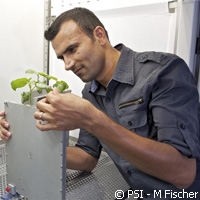Soil holds more water near plant roots
The movement of water from soil into roots controls the relationship between plants and water as well as how nutrients are absorbed. And while scientists have long recognised that roots trigger changes in the chemical, biological and physical properties of the rhizosphere (soil in the roots' immediate vicinity), new research shows that the soil in this vicinity actually contains 30 % more water than initially thought. Presented in the journal New Phytologist, the study was funded in part by the WATER WATCH ('Non-invasive imagining of the water dynamics in a soil plant groundwater system') project, which received a Marie Curie Actions - Transfer of Knowledge grant worth EUR 302,000 under the EU's Sixth Framework Programme (FP6). Researchers in Germany, Switzerland and the United States say water helps plants through short periods of drought. The results could be used to improve plant breeding and support the development of efficient irrigation systems. Using neutron tomography at the Paul Scherrer Institute (PSI) in Switzerland, the team showed the distribution of water to a fraction of a millimetre without removing any plants from the soil. 'The question of how plants take up water is not only relevant to the development of new, water-efficient strains of plants, but also for improving climate models,' explains co-author Sascha Oswald from the Institute of Earth and Environmental Science at the University of Potsdam in Germany, 'because typically more than half of all the water that falls onto the Earth's surface as rain in a humid climate is taken up by plants and then passes back to the atmosphere through the plants.' For his part, lead author Ahmad Moradi from the University of California Davis in the United States says: 'Plants take water up from the ground by means of fine roots, a few millimetres in diameter. Their thicker roots serve more as pipelines, to relay the water. We want to understand the water distribution around these roots. The decisive processes occur here at a scale of a few millimetres. In order not to miss these processes, we need a procedure that shows details that are smaller than a millimetre and that can be applied without needing to remove the plant from the soil.' Thanks to this sophisticated method, the team sent neutrons through plants, together with the soil around the roots. The particles enabled them to observe the interior of various objects, similar to an X-ray, but better; it is possible to view internal components. According to the researchers, water attenuates and scatters neutrons while metal and sand are invisible to them. Says Dr Moradi: 'Roots consist to almost 90% of water. When one wants to examine them, or the movement of water in the soil, then neutrons are far better tools than X-rays.' They created a three-dimensional (3D) image of the water distribution around the roots and established the amount of water present at various positions in the soil. 'The microscope option of the facility was used for this measurement, so that images with a resolution of 20 pixels per millimetre could be generated,' says co-author Eberhard Lehmann of the PSI. 'In this way, it was possible to make the water visible to the required accuracy. 'We have three measurement stations at which we can create images with neutrons - each with its own characteristics. Thus we were able to try out different options for the experiment. A great advantage of the PSI facility is also that it is in operation 24 hours a day, and thus plants could be observed over a complete day-night cycle.' Commenting on the findings, Professor Oswald, one of the authors of the study, says: 'If one thinks about the practical applications of these results, then they can help in the breeding of plants which can survive dry periods better. One could also learn exactly how much to water plants, so that they do not come to long-lasting harm through drying out.'For more information, please visit: New Phytologist: http://onlinelibrary.wiley.com/journal/10.1111/(ISSN)1469-8137(opens in new window) University of Potsdam: http://www.uni-potsdam.de/english/(opens in new window) Paul Scherrer Institute (PSI): http://www.psi.ch/psi-home(opens in new window) Marie Curie Actions: http://ec.europa.eu/research/mariecurieactions/(opens in new window)
Countries
Switzerland, Germany, United States



